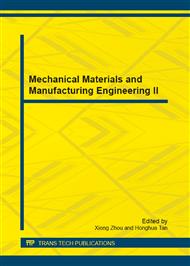p.147
p.153
p.162
p.167
p.173
p.179
p.185
p.190
p.199
The Effect of Nozzle Breakaway Pressure on the Spray Pattern Formed
Abstract:
The main function of a fuel injector nozzle is to break fuels into droplets, form the spray pattern, and propel the droplets into a combustion chamber. The amount of spray volume at a given operating pressure, the travel speed, and spacing between the jets of fuel can also be determined by the nozzle. In fuel injection, the smallest possible droplet size is desired for the most flow. This work presents an opportunity to use the Schlieren arrangement as a visualization method to view the flow of fuel from a three-hole fuel injector nozzle which cannot be seen by the naked eye. The jet flow of diesel Fuel was investigated by Schlieren photography. A test rig was designed and constructed to accommodate the nozzle; optical mirrors were arranged according to Schlieren specifications in order to allow the jet to be photographed. The breakaway pressure of the nozzle was varied between 60bar to 80bar. Each hole of the nozzle is 0.26mm in diameter and 120° apart; the third jet could not be seen from the images because the camera took x-y dimension images. The spray pattern observed from the two dimensional images of the jets developed were seen to be well dispersed. Su et al [3] found that emissions could be reduced in diesel engines if the injector nozzle produces smaller and more dispersed droplets.
Info:
Periodical:
Pages:
173-178
Citation:
Online since:
December 2012
Authors:
Keywords:
Price:
Сopyright:
© 2013 Trans Tech Publications Ltd. All Rights Reserved
Share:
Citation:


